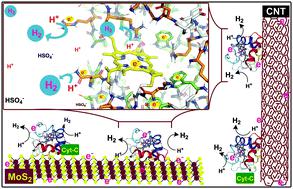当前位置:
X-MOL 学术
›
Mater. Chem. Front.
›
论文详情
Our official English website, www.x-mol.net, welcomes your feedback! (Note: you will need to create a separate account there.)
In situ surface modification of bulk or nano materials by cytochrome-c for active hydrogen evolution catalysis
Materials Chemistry Frontiers ( IF 7 ) Pub Date : 2020-10-26 , DOI: 10.1039/d0qm00627k Pallavi Thakur 1, 2, 3 , Jamsad Mannuthodikayil 1, 2, 3 , Golap Kalita 4, 5, 6, 7 , Kalyaneswar Mandal 1, 2, 3 , Tharangattu N. Narayanan 1, 2, 3
Materials Chemistry Frontiers ( IF 7 ) Pub Date : 2020-10-26 , DOI: 10.1039/d0qm00627k Pallavi Thakur 1, 2, 3 , Jamsad Mannuthodikayil 1, 2, 3 , Golap Kalita 4, 5, 6, 7 , Kalyaneswar Mandal 1, 2, 3 , Tharangattu N. Narayanan 1, 2, 3
Affiliation

|
Protein assisted electrochemical hydrogen evolution catalyst development has been proposed here. The surfaces of carbon nanotubes (CNTs) and bulk MoS2 are modified with the metalloprotein cytochrome c, where the CNT–protein covalent functionalization is found to be attained via electrochemical cycling in acid medium. The hydrophobic interaction mediated surface modification of MoS2 is found to produce a highly active hydrogen evolution catalyst, much superior to bare MoS2 crystals while on par with CNT functionalized protein catalysts. Hence a strategy for active catalyst development which works both in bulk and nanomaterials is established.
中文翻译:

细胞色素C原位修饰大块或纳米材料表面以进行活性氢释放催化
在此提出了蛋白质辅助电化学放氢催化剂的开发。碳纳米管(CNTs)和大量MoS 2的表面被金属蛋白细胞色素c修饰,发现通过酸性介质中的电化学循环可实现CNT-蛋白共价功能化。发现疏水相互作用介导的MoS 2的表面改性可产生高活性的析氢催化剂,远远优于裸MoS 2晶体,而与CNT官能化的蛋白质催化剂相当。因此,建立了一种在本体和纳米材料中都起作用的活性催化剂开发策略。
更新日期:2020-11-03
中文翻译:

细胞色素C原位修饰大块或纳米材料表面以进行活性氢释放催化
在此提出了蛋白质辅助电化学放氢催化剂的开发。碳纳米管(CNTs)和大量MoS 2的表面被金属蛋白细胞色素c修饰,发现通过酸性介质中的电化学循环可实现CNT-蛋白共价功能化。发现疏水相互作用介导的MoS 2的表面改性可产生高活性的析氢催化剂,远远优于裸MoS 2晶体,而与CNT官能化的蛋白质催化剂相当。因此,建立了一种在本体和纳米材料中都起作用的活性催化剂开发策略。



























 京公网安备 11010802027423号
京公网安备 11010802027423号